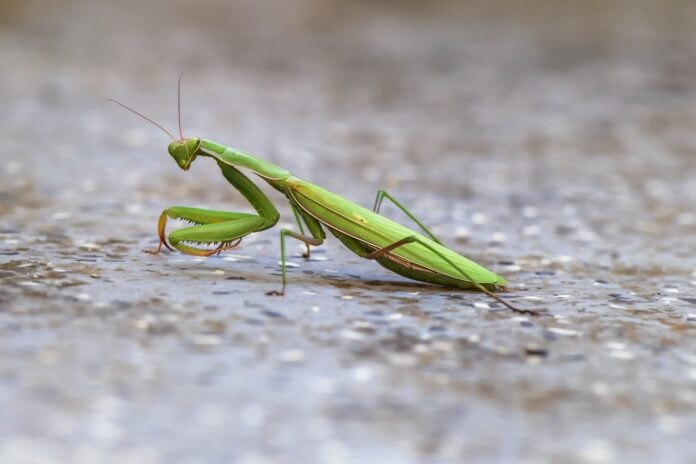The praying mantis gets its name from its posture, where its front legs resemble human hands folded in prayer.
Description and Structure
Praying mantises are distinguished by their long bodies, which can reach up to 17 cm. However, some species are much smaller, measuring just 0.5 to 1 cm. These predatory insects have a triangular head, which is highly mobile and can rotate 180 degrees, allowing them to detect approaching danger.
They have two pairs of wings: the front and rear wings. Most species can fly, although some are wingless and resemble larvae. The color of the mantis’ body depends on its environment, allowing it to blend in perfectly. They can be vibrant green like young leaves or brown like shrub branches, while some species have striking, contrasting colors.
Females are always significantly larger than males.
Species
There are about 2,000 species of praying mantises. Here are some of the most interesting ones:
- Indian Flower Mantis: Found in South Asia, this mantis lives among flowers and is most active during the day. It’s relatively small, with females reaching 4 cm. Their cream-colored bodies are marked with green and brown spots. The upper pair of wings has an eye-like pattern for scaring predators.
- Orchid Mantis: Known for its beauty, this species is found in tropical regions among orchid plants. Its body resembles a flower and is usually white with pink and yellow hues. Females can grow up to 8 cm and are aggressive hunters.
- Devil’s Flower Mantis: Found in East Africa, these large mantises, with females reaching up to 14 cm, have a unique appearance with leaf-like appendages. When threatened, they flare their colorful abdomen, spread their wings, and make a hissing sound.
- Spiny Flower Mantis: Widespread in Eurasia and Africa, this species is distinguished by a crown-like growth on its head. It can change colors frequently.
- Malaysian Dead Leaf Mantis: Found in the tropical forests of Malaysia and Indonesia, these mantises look like withered leaves and are typically brown.
- African Stick Mantis: This species inhabits dry African regions and resembles dry twigs. They can stand motionless for hours, waiting to ambush prey with a swift strike.
Habitat
Praying mantises are found in a wide range of environments across Europe, Asia, Africa, the Americas, and Australia. They are well-adapted to various climates, from tropical forests to temperate meadows and deserts.
These insects are not migratory and stay within their habitat if food is plentiful. However, attacks from snakes, birds, or other mantises may force them to relocate.
Interesting Facts
Praying mantises have some unique and fascinating traits:
- They can change color after each molt.
- Most males die after mating. Females often eat them to gain protein necessary for reproduction.
- Females can lay eggs without mating if they have sufficient nutrition, although not all will survive.
- In the USSR, attempts were made to introduce mantises to fields to control pests, but they also started hunting beneficial pollinators like bees, leading to the practice being abandoned.
- The martial art “Kung Fu” includes 12 moves that mimic mantis hunting and defense techniques.
- Mantises can eat and digest poisonous creatures, such as venomous spiders and ladybugs, without harm.
- They always eat live prey, avoiding dead or decomposing food.
- Mantis eggs are protected by a special capsule, making them resistant to extreme weather and chemicals.
- They have sharp vision and can spot other creatures up to 18 meters away.
- While they don’t typically attack humans, some large species can scratch the skin if provoked, but they aren’t poisonous.
